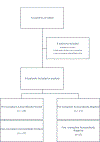Prevalence of antibodies to lung self-antigens (Kα1 tubulin and collagen V) and donor specific antibodies to HLA in lung transplant recipients and implications for lung transplant outcomes: Single center experience
- PMID: 30794945
- PMCID: PMC6513684
- DOI: 10.1016/j.trim.2019.02.006
Prevalence of antibodies to lung self-antigens (Kα1 tubulin and collagen V) and donor specific antibodies to HLA in lung transplant recipients and implications for lung transplant outcomes: Single center experience
Abstract
Purpose: For patients with end stage lung disease, lung transplantation (LT) remains the only definitive treatment option. Long term survival post LT is limited by acute and chronic allograft dysfunction. Antibodies to lung self-antigens Kα1Tubulin and collagen V (autoantibodies) have been implicated in adverse outcomes post LT. The aim of our study was to determine the prevalence of autoantibodies in pre- and post-transplant sera, evaluate the impact on post-transplant outcomes.
Methods: In a prospective observational cohort analysis, 44 patients were enrolled who received LT between 09/01/2014 and 10/31/2015. Pre- and post-transplant sera were analyzed using enzyme-linked immunosorbent assay (ELISA) for the presence of antibodies to collagen I, collagen V, and K-alpha 1 tubulin. The outcome variables are presence of primary graft dysfunction (PGD), cumulative acute cellular rejection (ACR), treatment with pulse steroids for clinical rejection, association with DSA, and onset of Bronchiolitis Obliterans Syndrome (BOS).
Results: In our cohort, 33 patients (75%) tested positive for the presence of autoantibodies. Pre-transplant autoantibodies were present in 23 patients (70%). Only a small percentage (26%) cleared these antibodies with standard immunosuppression. Some developed de novo post-transplant (n = 10). PGD was observed in 34% of our cohort, however the presence of autoantibodies did not correlate with increase in the incidence or severity of PGD. The prevalence of donor specific antibodies (DSA) in the entire cohort was 73%, with an increased prevalence of DSA noted in the autoantibody positive group (78.7% vs. 54.5%) than in the autoantibody negative group. BOS was observed in 20% of the cohort, with a median time to onset of 291 days' post-transplant. Patients with pre-transplant autoantibodies had a statistically significant decrease in BOS-free survival (p = 0.029 by log-rank test).
Conclusions: In our cohort, we observed a high prevalence of autoantibodies and DSA in lung transplant recipients. Pre-transplant autoantibodies were associated with de novo development of DSA along with a decrease in BOS-free survival. Limitations to our study include the small sample size and single center enrollment, along with limited time for follow-up.
Keywords: Autoantibodies; Bronchiolitis obliterans syndrome; Donor specific antibodies; Lung transplant; Primary graft dysfunction.
Published by Elsevier B.V.
Conflict of interest statement
Figures






References
-
- Yusen RD, Edwards LB, Dipchand AI, et al. The Registry of the International Society for Heart and Lung Transplantation: Thirty-third Official Adult Lung and Heart-Lung Transplantation Report−-2016; Focus Theme: Primary Diagnostic Indications for Transplant. J Heart Lung Transplant 2016; 35:1170–1184. - PubMed
-
- Meyer KC, Raghu G, Verleden GM, et al. An international ISHLT/ATS/ERS clinical practice guideline: diagnosis and management of bronchiolitis obliterans syndrome. Eur Respir J 2014;44:1479–503. - PubMed
-
- Hachem RR, Khalifah AP, Chakinala MM, et al. The significance of a single episode of minimal acute rejection after lung transplantation. Transplantation 2005;80:1406–13. - PubMed
Publication types
MeSH terms
Substances
Grants and funding
LinkOut - more resources
Full Text Sources
Medical
Research Materials
Miscellaneous

